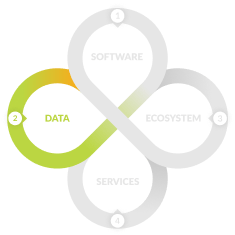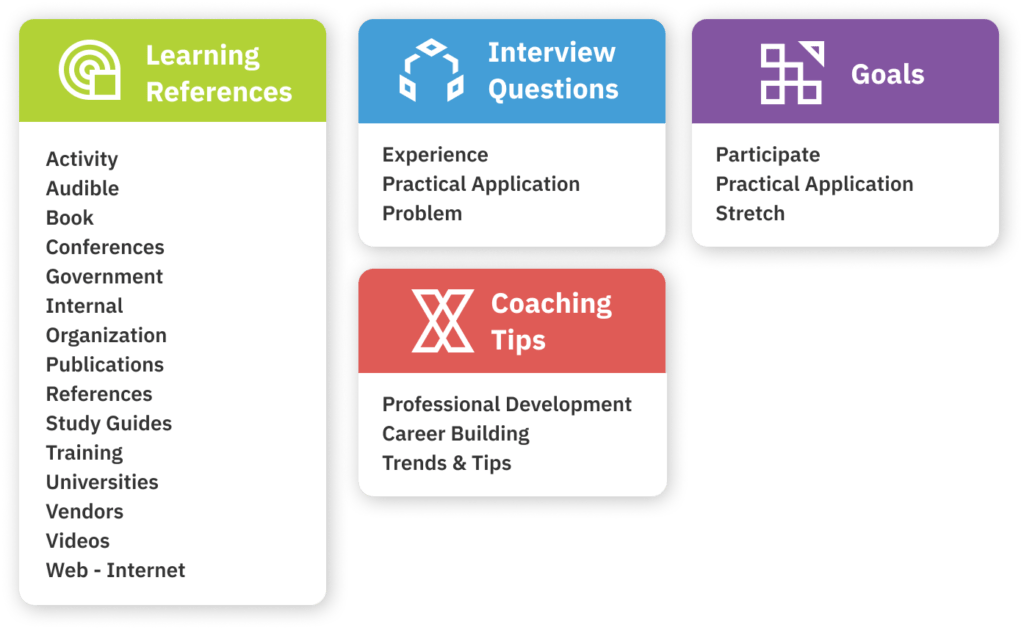
Talent Frameworks
Pave the Way for Digital Transformation
TalentGuard Talent Frameworks provide a readily deployable job taxonomy and competency library. With over 30 years of curation, it includes industry benchmarks for over 4,000 job profiles and 3,000 associated skills. This data can be customized by each company, serving as a foundational resource for swift implementation of talent management applications.

Prepare for the Jobs and Skills of the Future with Talent Frameworks
TalentGuard Talent Frameworks provide a blueprint for your workforce with clear identification of specific functional and technical skills needed for jobs in your industry. By leveraging this well-structured and comprehensive database, your organization can quickly and effectively launch new talent management solutions, reducing the time and effort required for setup and deployment. This rich, skill-focused content is curated with the help of TalentGuard WorkforceGPT Copilot, our advanced AI technology, to ensure accuracy and relevance to current industry standards.

Time to Implement
Implementing a pre-built talent framework enables companies to deploy a comprehensive talent management system 9+ months faster than if they had developed it manually, allowing them to quickly align their workforce with strategic goals and enhance overall performance.
Time to Competency
By introducing a structured training program, companies can reduce the time to competency from 10 months to just 3months, enabling employees to rapidly gain the skills needed to excel in their job role.
Training Program Effectiveness
Achieve a 10 to 15 percentage point increase in training program effectiveness, measured by improvements in knowledge retention, skill application, and post-training performance.

One source of truth for job & skill data
Accelerate the curation, mapping, and management of skills and job data with unmatched speed and precision. Powered by our advanced AI engine, we customize our rich, nuanced skill database to align seamlessly with your organization’s unique needs—eliminating the burden of building from scratch. Whether you choose to launch with our ready-to-use Talent Frameworks or leverage WorkforceGPT to generate bespoke competency and job models, you gain the flexibility to scale intelligently.
Explore the depth of our industry-specific Talent Frameworks in our comprehensive data model.


Standardized Taxonomy
A standardized taxonomy is a foundational element of effective talent management. It ensures consistency, clarity, and fairness across all HR processes, enhances employee development and engagement, and supports strategic organizational growth. A standardized taxonomy provides a common language for describing job roles, skills, and competencies across the organization.
This consistency ensures that everyone understands the expectations and requirements of each role, reducing confusion and miscommunication. It ensures consistency, clarity, and fairness across all HR processes, enhances employee development and engagement, and supports strategic organizational growth.

Accelerator Content
Our talent frameworks include content that improves employee engagement. Each skill includes 4 accelerators, including interview questions, coaching tips, development references and learning resources.
- Interview guides provide a guide for accurately assessing candidates.
- Coaching tips support managers in facilitating clear, objective performance reviews.
- SMART development statements give employees specialized, actionable practices to help them improve.
- Learning references provide a path for growth and development.

Ready-to-Use
TalentGuard provides the confidence, content, and coverage you need to jumpstart your transformation, leading to better results, faster. The robust content library, enriched with industry-specific job profiles, competencies, and skill descriptions, ensures that your HR practices are based on accurate and up-to-date information. This extensive coverage allows for a seamless implementation of talent management strategies across all levels of the organization, from recruitment and onboarding to performance management and career progression.
Talent Framework Architecture Overview
Our Talent Framework is comprised of the architecture components listed below. Check out our best practices for modifying the architecture to meet your organization’s needs.
Skills
Our competency and skill framework contains thousands of skills and competencies across dozens of industry segments. Each skill contains 4 levels of proficiency.
Job Content
Each job role includes a job title, job code, job description, four primary responsibilities, job family, job band, job focus, lead time, turnover percdent and 4 levels of competency proficiency.
Competency Types
Contains many types of competencies including: Foundational, Leadership and Technical.
Proficiency Descriptors
Each competency comes standard with 21 or more behavioral statements across four proficiency levels. This helps set clear expectations of what good looks like in specific job roles.
Learning References
Competencies are associated with suggested learning references including training experiential, web-based, group sessions and seminars.
Development Goals
Quantitative and qualitative SMART development statements are provided to facilitate employee learning and development.
Interview Questions
Interview questions are aligned to the competencies associated to the job role. This enables consistent selection over time for positions.
Coaching Tips
Provides managers with coaching recommendations on methods to improve behavior and experiences that need to be shared.
Job Grades
Offers levels of jobs by scope of responsibility using six broad bands (1-6). We use the same 6 bands across all frameworks and all jobs.


